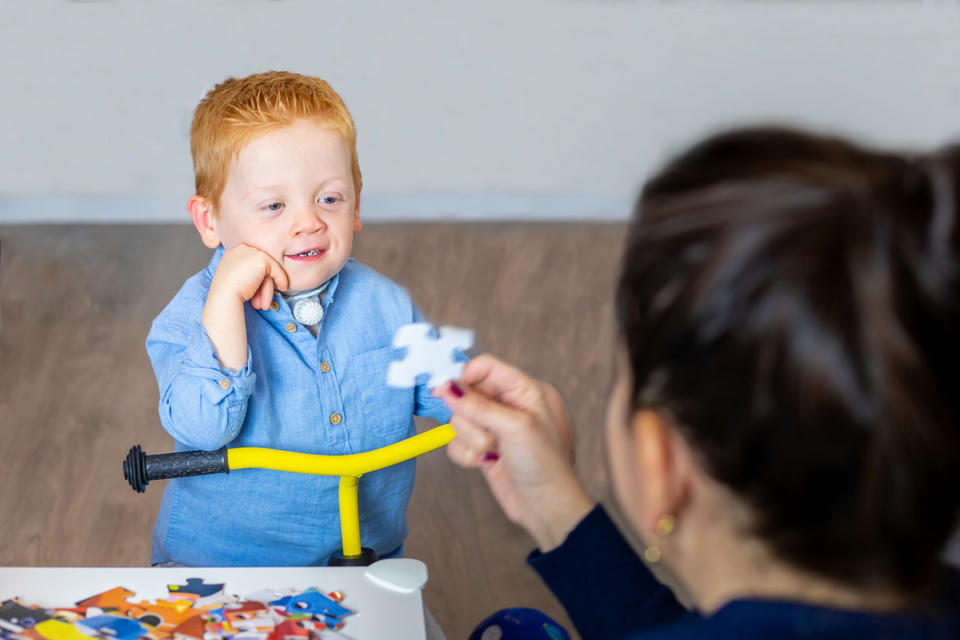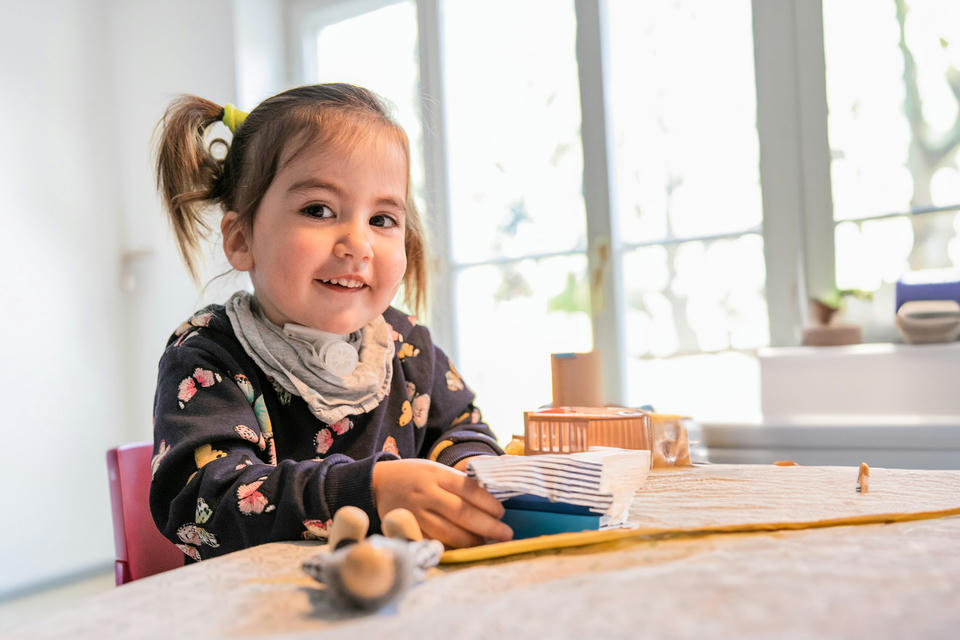Pediatric Tracheostomy Management
In Atos, we are dedicated to enhancing the lives of children with tracheostomies and their families. Our mission is to provide comprehensive support through a range of high-quality products and valuable services. From specialized tracheostomy tubes to innovative solutions for pulmonary health, speech development, and daily care, we are committed to making the journey with a tracheostomy easier. Explore our offerings and join a community focused on empowering pediatric care. Together, we strive to create a brighter, healthier future for every child in need.

Children with a Tracheostomy
When caring for children requiring a tracheostomy, it's crucial to recognize their unique characteristics and developmental stages. Children, distinct from adults, undergo continuous anatomical, physiological, social, emotional, physical, and cognitive changes from birth to adulthood.1-3 Moreover, the reasons for tracheostomy can vary significantly, such as addressing pulmonary challenges or ventilation needs after premature birth. The placement of a tracheostomy in infancy or childhood can potentially impact and disrupt their developmental milestones.4,5
Adjustment to Growth and Sensitivity
In caring for a child or young person with a tracheostomy, it is crucial to ensure that medical products adapt to the child's evolving size and growth stage while respecting the changing anatomical dimensions of their airways.3,6 The sensitive anatomical structures are susceptible to damage from manipulation and pressure, such as compression or rubbing of the tracheal mucosa by a tube. Prolonged use of a tube may lead to irreversible damage and stenosis (narrowing of the airway).6,7


Understanding the Impact of Tracheostomy Placement
Considering the rationale behind tracheostomy placement and associated comorbidities is essential, as they can influence a child's overall health.8,9 Parents and caregivers, educated on managing care in community settings, face challenges and burdens.10,11 Despite this, children and young people with tracheostomies and their families often exhibit resilience, navigating the journey from insertion to transitioning back into familiar routines.11,12
Learn moreTailoring Tracheostomy Tube Dimensions for Pediatric Well-Being

The dimensions of a tracheostomy tube, especially the length and diameter, dynamically adjust to the growth and development of the child or young person.3,5 Even slight millimeter changes can significantly affect the positioning and placement of the tracheostomy tube, including its distance from the carina. This adaptive sizing continues in the growing child, ensuring ongoing optimization of the child's overall well-being.6
Proximally Longer Tracheostomy Tubes

For infants or children with limited neck space or poor head control, a proximally longer tracheostomy tube with a standard 15 mm connector provides enhanced accessibility. This positioning helps to keep connectors away from the neck, chin, and stoma and helps to minimize ventilation circuits from being disconnected.6
Effects on Pediatric Pulmonary Health
The redirection of airflow through a tracheostomy, bypassing the upper airway, can disrupt crucial physiological functions such as voicing, communication, swallowing, coughing, and bearing down in developing children. This is particularly significant as these skills are actively evolving in a child.13-17 Additionally, a child's respiratory system and immunity are in the developmental stages from infancy to adulthood, making them susceptible to respiratory infections.18,19 The positioning of the tracheostomy at the entry to the lower airway increases the risk of infections and hospital admissions. Hence, prioritizing respiratory health is vital to mitigate these potential negative consequences.20-23

A Tracheostomy Impacts Humidification and Filtration
A tracheostomy bypasses the upper airway, and when breathing through a tracheostomy tube, the important, natural humidification and filtration functions are mostly lost. The tracheostomy creates an open portal of entry for unconditioned air, viruses, bacteria and other fine airborne particles and pathogens to enter directly into the trachea and lungs (lower airway).
Children with a tracheostomy have a higher risk of respiratory infections.18,19,21 This is due to the naturally protective oral and nasal passages being bypassed, allowing microorganisms into the lower airways more easily. Also, it is recognized that prolonged use of a tracheostomy tube can irritate the mucosa of the trachea, further increasing infection risk.20,24 Long-term tracheostomy use has been associated with colonization of microorganisms such as Pseudomonas and Staphylococcus.23,25,26,29 Bacterial pneumonia is the most common reason for hospitalization in tracheostomized children.23
The use of Heat and Moisture Exchangers (HMEs) by patients with a tracheostomy optimizes heat and moisture qualities of the inspired air and therefore improves pulmonary function. Optimizing humidification and warmth of inspired air leads to decreased viscosity of mucus secretions, less irritation from dry airways, minimizes coughing, and improves respiratory functions.5,25,27-30
Learn moreRerefences
1 Edwards L, McRae J. Transitions in tracheostomy care: from childhood to adulthood. Current Opinion in Otolaryngology & Head and Neck Surgery. 2023; 10-1097.
2 Nakarada-Kordic I, Patterson N, Wrapson J, Reay SD. A systematic review of patient and caregiver experiences with a tracheostomy. Patient. 2018 Apr;11(2):175-191.
3 Watters K. Tracheostomy in infants and children. Pediatric tracheostomy. Respiratory Care. 2017; Vol. 62(6):803.
4 Fuller C, Wineland AM, Richter GT. Update on pediatric tracheostomy: indications, technique, education, and decannulation. Current Otorhinolaryngology Reports. 2021; 9:188-199.
5 Okonkwo I, Cochrane L, Fernandez E. Perioperative management of a child with a tracheostomy. BJA education. 2020; 20(1):18.
6 Tweedie DJ, Cooke J, Stephenson KA, Gupta SL, Pepper CM, Elloy MD, et al. Paediatric tracheostomy tubes: recent developments and our current practice. The Journal of Laryngology & Otology. 2018; 132(11):961-968.
7 Muller RG, Mamidala MP, Smith SH, Smith A, Sheyn A. Incidence, Epidemiology, and Outcomes of Pediatric Tracheostomy in the United States from 2000 to 2012. Otolaryngology–Head and Neck Surgery. 2019; 160(2):332-338.
8 Canning J, Mills N, Mahadevan M. Pediatric tracheostomy decannulation: When can decannulation be performed safely outside of the intensive care setting? A 10 year review from a single tertiary otolaryngology service. Int J Pediatr Otorhinolaryngol. 2020 Jun;133:109986.
9 Flanagan F, Healy F. Tracheostomy decision making: From placement to decannulation. Semin Fetal Neonatal Med. 2019 Oct;24(5):101037.
10 Gursoy TR, Eyuboglu TS, Aslan AT, Pekcan S, Buyukkaya EZ, Hangul M, et al. The associations between the clinical course of children with tracheostomy and their mothers’ depression, burnout, burden, and self-esteem. Journal of Clinical Nursing. 2023; 32(13-14):3412-3420.
11 Hall N, Rousseau N, Hamilton DW, Simpson AJ, Powell S, Brodlie M, et al. Providing care for children with tracheostomies: a qualitative interview study with parents and health professionals. BMJ open. 2023; 13(1):e065698.
12 Flynn A, Whittaker K, Donne AJ, Bray L, Carter B. Feeling stretched: parents’ narratives about challenges to resilience when their child has a tracheostomy. Journal of Child Health Care. 2023; 13674935231169409.
13 Pullens B, Streppel M. Swallowing problems in children with a tracheostomy. In Seminars in Pediatric Surgery. WB Saunders. 2021 June; 30(3):151053.
14 DeMauro SB, D’Agostino JA, Bann C, Bernbaum J, Gerdes M, Bell EF, et al. & Eunice Kennedy Shriver National Institute of Child Health and Human Development Neonatal Research Network. Developmental outcomes of very preterm infants with tracheostomies. The Journal of pediatrics. 2014; 164(6):1303-1310.
15 Hess DR. Facilitating speech in the patient with a tracheostomy. Respiratory Care. 2005; 50(4):519–525.
16 Kraemer R, Plante E, Green GE. Changes in speech and language development of a young child after decannulation. Journal of communication disorders. 2005; 38(5):349-358.
17 Jiang D, Morrison GAJ. The influence of long-term tracheostomy on speech and language development in children. International journal of pediatric otorhinolaryngology. 2003; 67:S217-S220.
18 Sinha SK. The Respiratory System: Development and Physiology in the Neonate. In Clinical Anesthesia for the Newborn and the Neonate. Singapore: Springer Nature Singapore. 2023; 205-224.
19 Torres A, Cilloniz C, Niederman MS, et al. Pneumonia. Nat Rev Dis Primers. 2021; 7(25).
20 Powell J, Powell S, Mather MW, et al. Tracheostomy in children is associated with neutrophilic airway inflammation. Thorax. 2023; 78:1019-1027.
21 Morrison JM, Hassan A, Kysh L, Dudas RA, Russell CJ. Diagnosis, management, and outcomes of pediatric tracheostomy-associated infections: A scoping review. Pediatric pulmonology. 2022; 57(5):1145-1156.
22 Gipsman A, Prero M, Toltzis P, Craven D. Tracheobronchitis in children with tracheostomy tubes: Overview of a challenging problem. Pediatric Pulmonology. 2022; 57(4):814-821.
23 Zhu H, Das P, Roberson DW, Jang J, Skinner ML, Paine M, et al. Hospitalizations in Children with Preexisting Tracheostomy: A National Perspective. The Laryngoscope. 2014
24 Tan CY, Chiu NC, Lee KS, Chi H, Huang FY, Huang DTN, et al. Respiratory tract infections in children with tracheostomy. Journal of Microbiology, Immunology and Infection. 2020; 53(2):315-320.
25 Volsko TA, Parker SW, Deakins K, Walsh BK, Fedor KL, Valika T, et al. AARC Clinical Practice Guideline: management of pediatric patients with tracheostomy in the acute care setting. Respiratory care. 2021; 66(1):144-155.
26 Cline JM, Woods CR, Ervin SE, Rubin BK, Kirse DJ. Surveillance tracheal aspirate cultures do not reliably predict bacteria cultured at the time of an acute respiratory infection in children with tracheostomy tubes. Chest. 2012; 141(3):625-631.
27 de Kleijn BJ, van As-Brooks CJ, Wedman J, van der Laan BFAM. Clinical feasibility study of protrach dualcare a new speaking valve with heat and moisture exchanger for tracheotomized patients. Laryngoscope Investig Otolaryngol. 2017 Nov 27;2(6):453-458.
28 Vitacca M, Clini E, Foglio K, Scalvini S, Marangoni S, Quadri A, Ambrosino N. Hygroscopic condenser humidifiers in chronically tracheostomized patients who breathe spontaneously. Eur Respir J. 1994 Nov;7(11):2026-32.
29 Nelson Laboratories. Bacterial Filtration Efficiency (BFE) GLP Report. Salt Lake City, USA. Available on request from Atos Medical.
30 Nelson Laboratories. Viral Filtration Efficiency (VFE) GLP Report. Salt Lake City, USA. Available on request from Atos Medical.
31 Hess DR, Altobelli NP. Tracheostomy TubesDiscussion. Respiratory Care. 2014; 59(6):956- 973.
32 RP1, Myers C, Rutter MJ, et al. Prevention of tracheostomy-related pressure ulcers in children. Pediatrics. 2012; 129(3):e792-7.